The Climate Movement Is Making a Big Mistake by Opposing This Permitting Reform Bill
It makes it easier to build stuff in America, and there's a vast amount of new clean energy capacity waiting to be built.
The Permitting Reform Bill
On July 23, 2024, the Energy Permitting Reform Act of 2024 was introduced in the United States Senate, as the proposed bill S.4753. It is, broadly speaking, a messy compromise between clean energy and fossil fuel interests that leaves no one completely satisfied. (Here’s an in-depth breakdown). If passed (and it has a decent chance of passing, with considerable bipartisan support1) it would make it easier to establish new oil leases and export American liquified natural gas (LNG). But it would also make it much easier and simpler to build vital new clean energy projects, from solar farms to transmission lines to enhanced geothermal, at the speed and scale we need to address the climate crisis.
The bill was introduced by Joe Manchin of West Virginia and John Barrasso of Wyoming, two Senators known for their longtime connections to the fossil fuel industry. It’s understandable to distrust anything coming from them. But while the bill might have their names on it (sometimes it’s known as the “Manchin-Barrasso permitting reform bill”), it’s going to have much, much broader benefits. Several leading Democratic senators, like John Hickenlooper of Colorado and Martin Heinrich of New Mexico, are already strongly supporting it.
“I think it’s going to deal with some of these friction points to be able to get the full benefit of the Inflation Reduction Act.
In particular, transmission is a limiting factor for how quickly we transition the overall grid.”
-Sen. Martin Heinrich (D-NM)
Citizens’ Climate Lobby is supporting it. The renewable energy industry is excited about it.
“The Manchin-Barrasso bill could provide relief and reassurance to the United States’ burgeoning renewable energy industry.
Today, low-carbon energy sources account for over 95 percent of the 2,600 gigawatts of capacity in interconnection queues.
Only a fraction of these proposed projects, however, may end up being built; a mere 14 percent of total capacity that sought connection from 2000 to 2018 went into service, according to some estimates.
Local, state, and federal permitting roadblocks have been a chief culprit.”
-Ray Cai, Center for Strategic and International Studies.
And nonpartisan think tanks and strategic analysts tend to agree that this bill would be a huge plus for America’s and the world’s fight against climate change.
“Based on all my conversations, it is very quite clearly a net emissions reduction,”
-Xan Fishman, Bipartisan Policy Center
However, much of the U.S. environmental and climate movement, of which I consider myself a part, has already decided to oppose the permitting bill, including many venerable organizations such as the LCV and the NRDC. Bill McKibben, who I interviewed in 2023, who I read regularly, and who I profoundly respect and admire, wrote an impassioned and eloquent call to action against this bill.
I think that opposing this permitting bill is profoundly mistaken. Not just a little bit mistaken. Extremely mistaken. Diametrically opposed to the long-term interests of the fight against climate change.
I’m worried that the climate movement is about to self-sabotage massively by taking down a bill that has the potential to be the biggest long-term emissions reducer since the Inflation Reduction Act. If the well-intentioned, good-hearted climate activists who oppose this permitting bill actually win this fight and defeat the bill, they’ll unnecessarily slow down the renewables revolution by years if not decades. Entire organizations and hundreds of personal careers intended to be dedicated to fighting climate change could end up having the net effect of worsening climate change if they successfully stop this bill.
One major argument against the permitting reform bill seems to be that enabling new fossil fuel development (especially LNG exports) is such a negative that no amount of clean energy progress could outweigh it. Here’s one way this has been articulated.
“The ultimate goal of climate policy is not to rewire America so it can use more renewable energy. That is a good goal, and it will make money for solar and wind developers which is why many of them will support this bill. But the goal of climate policy is to prevent the planet from overheating. And if you make renewable energy easier in America at the cost of addicting developing Asian economies to exported American LNG, you have taken an enormous step backwards.”
-Bill McKibben, in his recent Substack post against the permitting bill.
The thing is, rewiring America so it can use more renewable energy is a vital way to prevent the planet from overheating! We need to switch our entire civilizational stack to run on clean electrons, not just replacing all our old electricity but providing enough new electricity for previously combustion-powered sectors like transport (EVs), heating (heat pumps), and heavy industry (electric arc furnaces). Bill McKibben himself has some of the best writing on the true epic scope of this! Humanity and our biosphere have a critical interest in generating more clean electrons, and this permitting bill would mean that we could get a lot more.
And also: renewables are winning the future globally. Developing Asian economies are building gigawatt-scale solar farms by the dozen, and adding a little more American LNG to the market in addition to the Qatari and Russian LNG already available isn’t going to stop that.
I get where Bill McKibben’s coming from on this, and I understand that after decades of heroically standing up to an all-conquering fossil fuel industry, the knee-jerk response must be to oppose anything that allows any additional fossil fuel development. And that would have been a very good decision-making heuristic for a climate activist, for decades! But in the last couple years, the world has changed immensely. It’s changed very fast, and it’s hard to keep up with. But it’s changed in a good way, and a way that’s “flipped the sign” on the climate impact of things like this permitting bill.
If I had to simplify the climate action case for permitting reform to one sentence, it would be this: Permitting reform makes it a lot easier to build new stuff in general, and the overwhelming majority of the new stuff getting built in America these days is cleaner and better for the planet than the old stuff it’s replacing.
This is a U.S. EIA map of new grid-scale power from all sources, set to come online across America from June 2024 through May 2025. It’s a sea of yellow solar farm icons and green wind farm icons, with a few scattered burnt-orange natural gas icons and zero coal icons.
That’s the map of what’s planned to get built in the upcoming year. Here’s the pie chart of what actually got built in 2023.
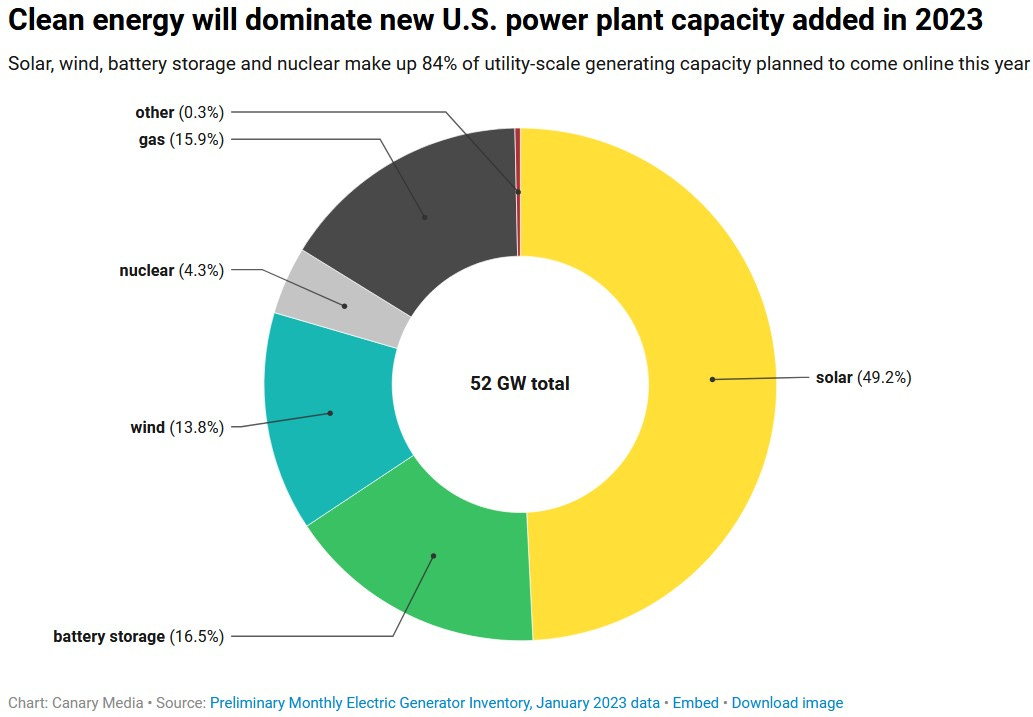
The overwhelming majority of all new electricity-generating capacity being built these days, in America as worldwide, is renewable.
As I wrote in a recent newsletter: a new report has found that renewable energy accounted for an incredible 85% of all new electricity-generating capacity built in 2023. That’s 85% of all new electricity projects built everywhere on Earth during the most recent full year!
The International Energy Agency’s World Energy Investment 2024 report just came out found that global investment in clean energy is now nearly double the total global investment in fossil fuels. Out of over $3 trillion (i.e. 3,000 billion) in total global energy investment, around $2 trillion is going to clean technologies compared to just over $1 trillion for fossil fuels.
This is why I’m not too worried about the permitting bill resulting in Asian economies getting addicted to LNG. Clean energy is where it’s at, where the cost-benefit analyses and capital flows and political incentives and national strategic planning are heading worldwide. We are well and truly in an era of the green building boom, and this permitting bill could help it happen faster, gaining precious time on a rapidly warming planet.
And there are some very strong reasons to believe that making permitting easier for clean energy in America will bring immense benefits. As this chart from Lawrence Berkeley National Laboratory clarifies, the line to plug in to the U.S. power grid (aka the “interconnection queue” is getting longer and longer. It’s reached over two thousand five hundred gigawatts of capacity, which is a truly gigantic amount. This line is made up of proposed electricity-generating projects (overwhelmingly solar, wind, and battery projects these days) that some developer or utility or cooperative wants to build, but that don’t have the permits to move forward, and/or don’t have the permits to build the extra power lines that would connect their new project to the grid. Even the unprecedented wave of new clean energy projects we’re getting now pales in comparison to this gigantic backlog of even more new clean energy projects that someone already wants to build, but can’t. That’s why this permitting bill could make an extremely impactful difference.
Here’s a chart with that same 2023 interconnection queue data, broken down by power source and compared to all existing 2023 capacity. It’s one of those charts that seems like it can’t possibly be true, but it is. There is far more already-proposed solar and battery capacity waiting to be built than there is all electricity-generating capacity from all sources already built! That’s an extraordinary situation.
As it stands, most projects in this queue will likely never be built. But the permitting bill could change that.
“We have to have the transmission changes in order to get to the clean energy future. It’s a bottleneck.
In my view, if we vote for this bill, it will get us enormous benefits in terms of emissions, and it will speed the transition. If we vote against, we will have a slower transition and fewer emissions reductions.”
-Angus King (I-ME), this writer’s U.S. Senator.
The climate movement’s primary goal, for years, was to stop things. Bad things, like mountaintop-removal coal mining and tar sands pipelines! Things that needed to be stopped! But the world has changed. We need to build a lot of new stuff to stabilize our atmosphere and become a clean electron-powered civilization. Fortunately, people now want to build huge amounts of new clean energy stuff, because it’s cheap and it works and it’s constantly getting better! In the 2020s, sensible environmentalism and effective climate activism needs to have a primary goal of BUILDING things. Bill McKibben, again, wrote one of the best articles about this, an all-time classic entitled “Yes in Our Backyards: It’s time progressives like me learned to love the green building boom.”
This exact same permitting reform bill, if introduced in 1994 or 2004 or maybe even 2014, might have been on-net a disaster for the climate, as the giveaways to fossil fuels wouldn’t have been outweighed by the massive win of lightening the permitting brake on a hyper-accelerating renewables revolution. But everything’s different now. In 2024, making it easier to build renewables brings some truly extraordinary benefits. The economics are now so far in favor of clean energy that taking away some of the last permitting barriers will unleash an even more rapid buildout than the one we’re already getting, supercharging the fight against climate change to an extraordinary degree.
And that may sound like some bloodless technocratic thing. “More emissions-free electricity-generating capacity” may not stir hearts and minds. But it should. It means we’ll be able to shut down coal plants faster, preventing a multitude of ills from PM2.5 junk in the air to mercury-laden coal ash seeping into the groundwater. It means that we can transition to EVs faster, reducing local air pollution and saving thousands of kids from childhood asthma. (I was a kid with severe childhood asthma once, and I wouldn’t wish it on my worst enemy). It means it’ll be easier to set up a 100% solar and battery-powered steel mill or factory or data center, creating new innovations without belching more carbon into the atmosphere. It means that there’ll be less greenhouse gases emitted into the atmosphere, and correspondingly a somewhat greater chance that the Great Barrier Reef and the Amazon Rainforest and the West Antarctic Ice Sheet make it into the 2100s. It means a better, healthier, less air polluted, less climate-destabilized future.
The climate movement doesn’t fully realize what’s at stake with this permitting bill, at least not yet. It’s led by good, selfless, kind-hearted people who nonetheless are working off assumptions that have not adapted to the changed world of the 2020s clean energy boom. The amazing growth of renewable energy in the past few years almost feels too good to be true, too fragile to be real. We, and I include myself in this, are still to some extent cowering before the afterimage of the historic might of fossil fuels, still trying desperately to stop anything that could give them more power in the short term, not realizing that they’re long-term on the way out at this point and the most effective way to reduce emissions is to speed up the advent of their replacement. (The Rocky Mountain Institute has a great post and report on the exponential drivers of the renewables revolution if you’d like more data on this).
Joe Manchin and Senate Republicans definitely don’t fully realize what’s at stake with this permitting bill. I suspect that they’re just hoping for a couple fossil fuel projects squeezed out of what they still deny is a dying giant, that they don’t know about or refuse to believe the clean energy growth statistics, and that as a result we have an amazing opportunity to supercharge the clean energy revolution by passing a bill heavily sponsored by fossil fuel interests. They’re trying to grab a few last desperate boosts for their dying dirty energy in exchange for lifting the last shackles slowing down our vibrant and fast-growing clean energy! That’s a good deal for clean energy.
I’m definitely not asking readers of this article to take my word for it or trust that I personally have some unparalleled expertise on this. Just…look at the data. Look at the stats on how clean energy now makes up almost all of the new electricity-generating capacity getting built. Look at the investment flows. Look at what the Lawrence Berkeley National Laboratory says about the amount of clean energy capacity just waiting in line for a chance to get the permit or power line they need to get built.
So here’s what I would ask- in fact beg, plead, and implore - from Bill McKibben and the entire climate movement, up to and including you the reader if you’re asked to take a position on this someday. Please don’t throw away this chance to unleash the true potential of the Inflation Reduction Act, electrify America and accelerate our clean electron-powered, climate-stable future. Even if you can’t bring yourself to support a Manchin-proposed bill, at least don’t oppose it, or at least focus on lobbying Senators on specific amendments without opposing the overall bill.
The Manchin-Barrasso bill is an ugly compromise with fossil fuel interests, but it also looks like our best chance this decade to accelerate a truly sustainable clean energy-powered future. I very much hope it passes, and climate activists should try to help it, not stop it.
On July 31, the permitting bill passed out of committee with a bipartisan 15-4 majority in favor. Three Democrats and one Republican Senator opposed the bill.

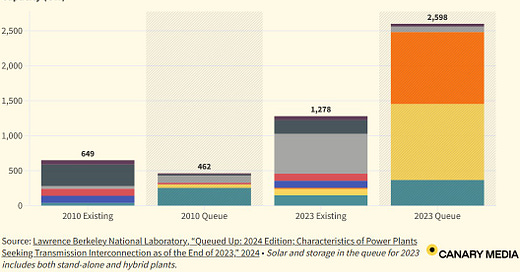


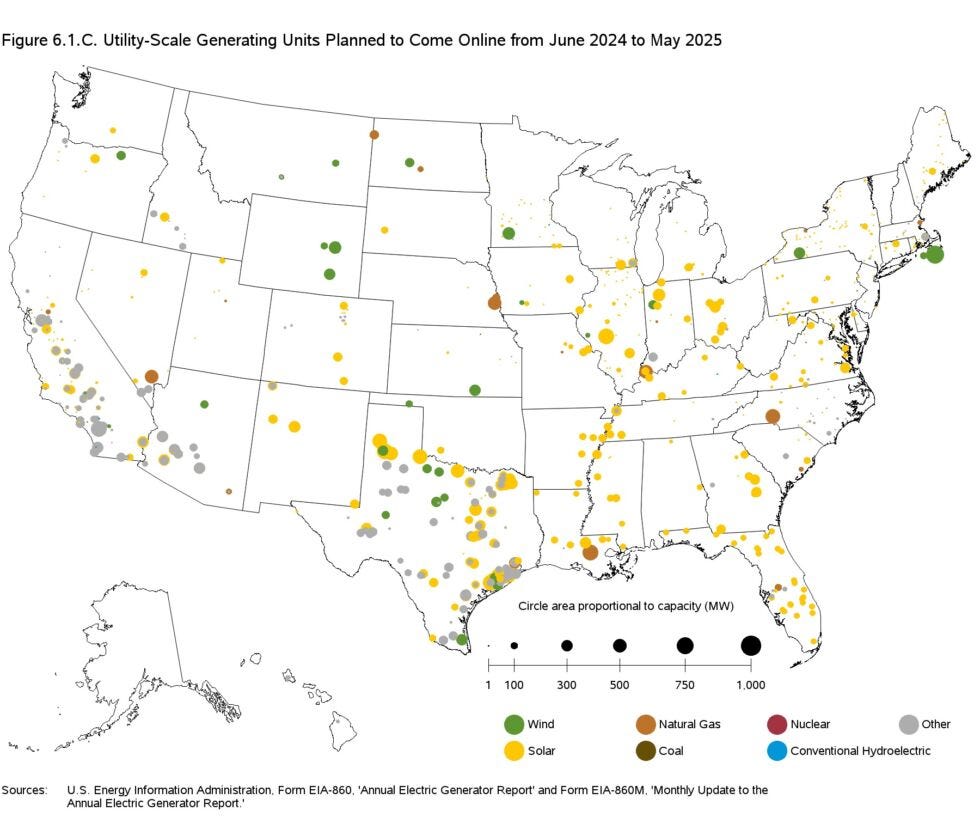
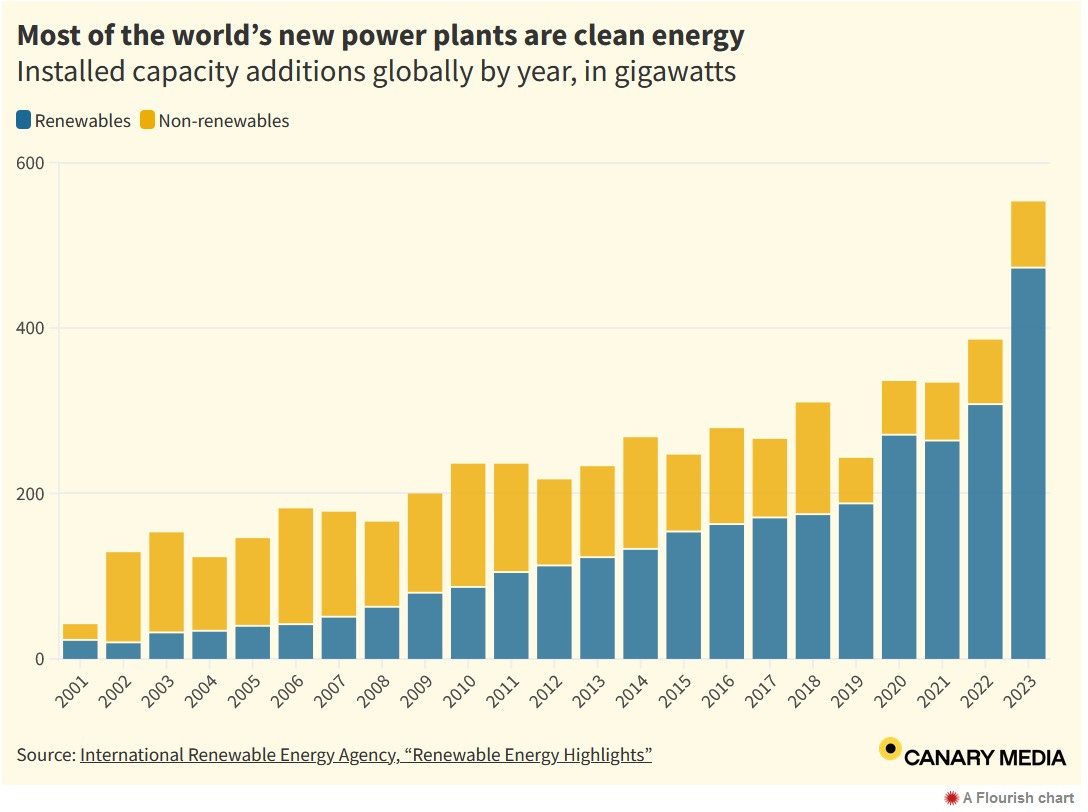

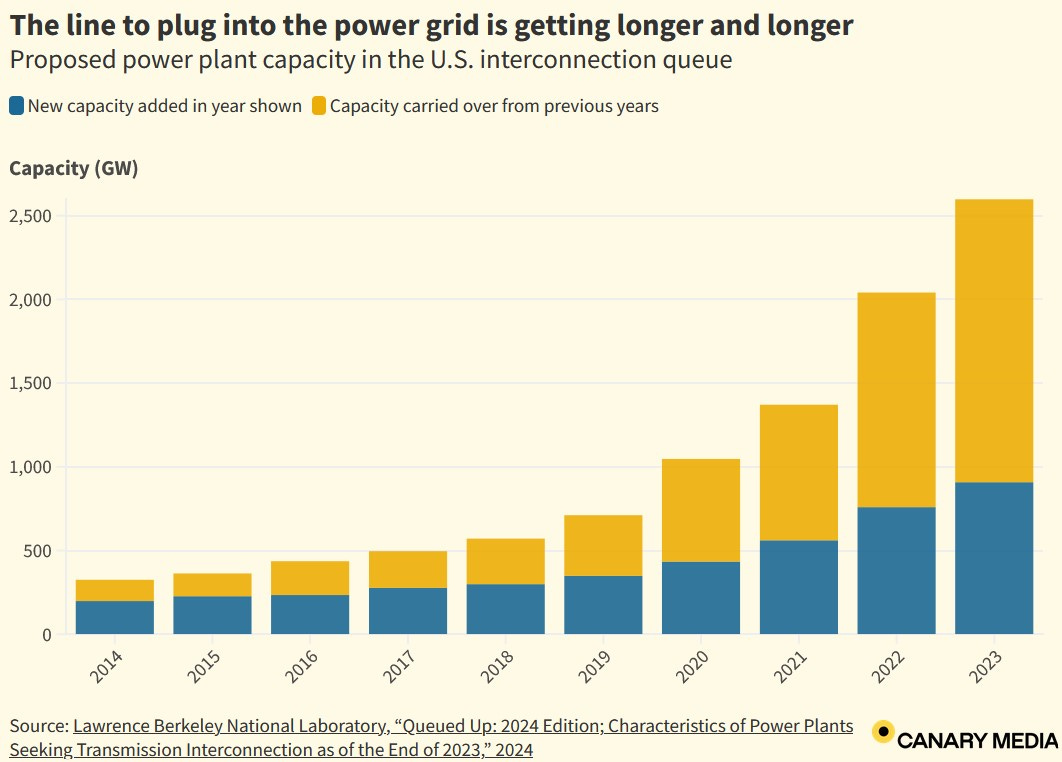


I’m with you, Sam, on the new #permittingreform bill that “just say no” carbon hawks like Bill McKibben are fighting. On LNG exports, as you write, “renewables are winning the future globally. Developing Asian economies are building gigawatt-scale solar farms by the dozen, and adding a little more American LNG to the market in addition to the Qatari and Russian LNG already available isn’t going to stop that.” On the overall need for speed in USA energy system development, you are right again: “Permitting reform makes it a lot easier to build new stuff in general, and the overwhelming majority of the new stuff getting built in America these days is cleaner and better for the planet than the old stuff it’s replacing.”
Yes! Seems like pragmatism is feasible now. The bill will hand both sides of the energy equation opportunities to expand, but we’re on the winning side now, so the advantage for clean energy will be exponentially larger. As a news-weary Brit, this is the first time I’m hearing about this, but now I’m crossing my fingers for this as much as I would be as an American.